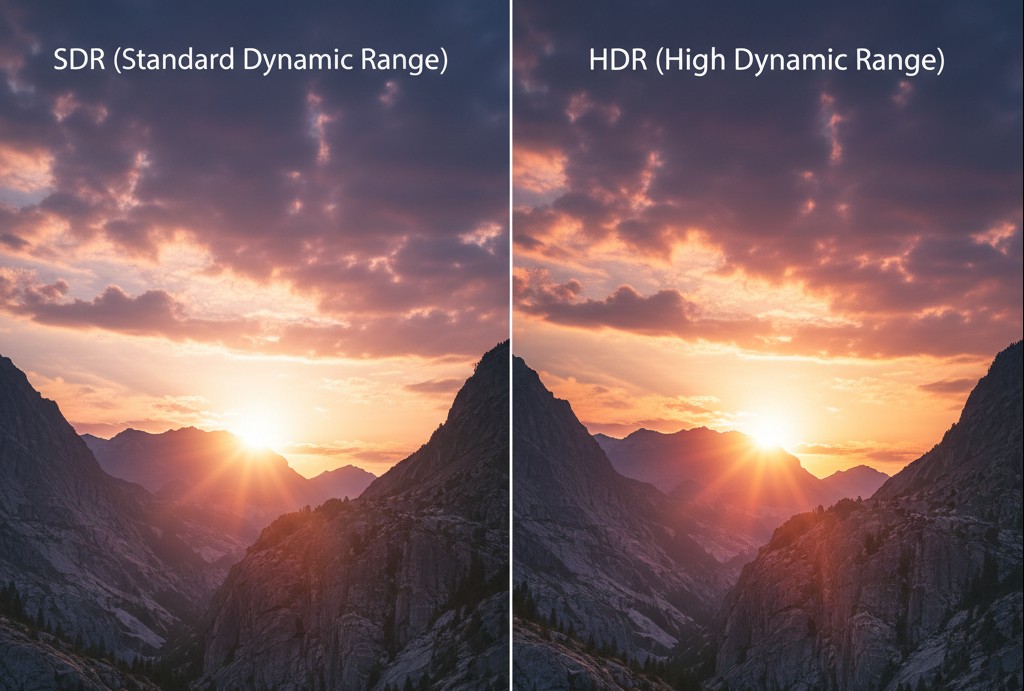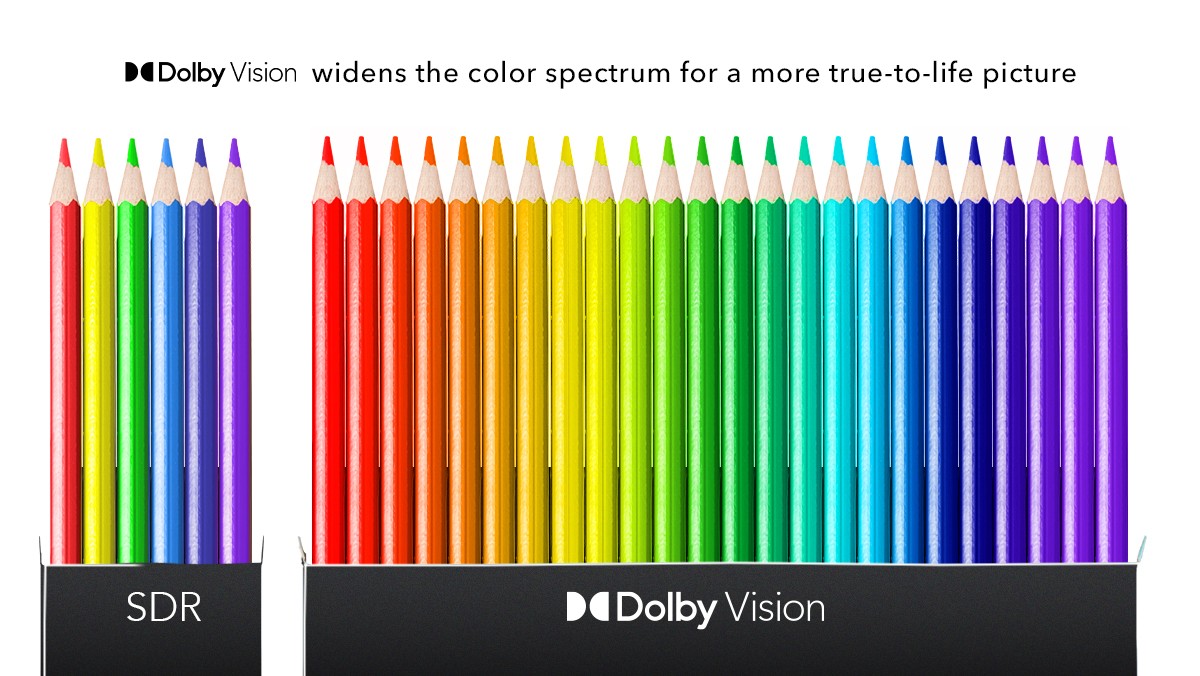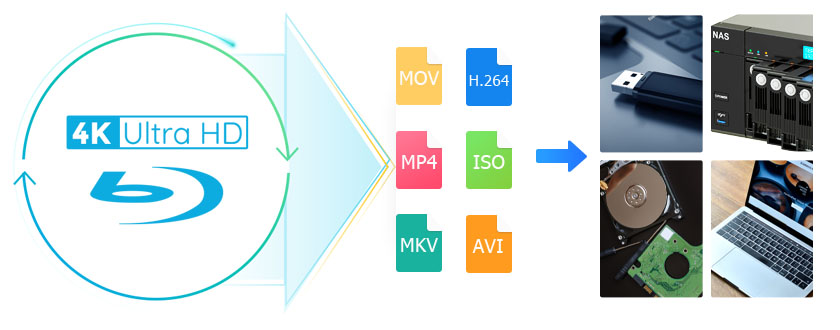Exploring HDR, HDR10, and Dolby Vision in Ultra HD Blu-ray Discs
Summary: This article explores the differences between HDR, HDR10, and Dolby Vision. It also looks at the full Ultra HD Blu-ray solutions DVDFab offers, designed to help you preserve HDR10 or Dolby Vision when copying or ripping 4K UHD discs.
Table of Contents

Since 2016, HDR video has moved from labs into living rooms across discs, streaming, and games. In this guide, I explain HDR, HDR10, HDR10+, and Dolby Vision in plain terms—what they are, how they differ on real screens, and what to expect on today's TVs, players, and PCs. Drawing on my own tests and vendor specs, I'll also outline practical playback and backup workflows. If you need a reliable way to preserve HDR10 or Dolby Vision when ripping or converting your UHD Blu-rays, I'll show where DVDFab fits into that toolkit—objectively, with settings that actually work.
Introduction to HDR, HDR10 and Dolby Vision
What's HDR?

High Dynamic Range (HDR) is a technology that lets videos show brighter highlights and darker shadows, giving more contrast and richer color than Standard Dynamic Range (SDR). Most HDR formats use 10-bit color, which helps reduce visible banding in smooth gradients.
HDR also includes metadata — extra information sent with the video signal that tells the display how the content was mastered (how bright the peaks are, and how dark the shadows). This metadata comes in different types: static metadata, which stays the same throughout the movie, and dynamic metadata, which adjusts scene by scene or frame by frame in formats that support it.
When the content, the display and the environment all work well together, HDR usually makes a visible difference. HDR preserves the gradation from dark to light in a way that SDR (Standard Dynamic Range) cannot. This allows both dark and very bright points of light to be fidelized with a great deal of detail and color.
What's HDR10?
HDR10 is an open standard for HDR video. It uses static metadata, which means the information about brightness and color volume is set once for the whole movie. Most HDR10 content is mastered for peak brightness between 1,000 and 4,000 nits, with 10-bit color depth and wide color gamut (BT.2020).
Because of these specs, HDR10 can show brighter lights and darker shadows than SDR in many cases. It offers a much larger color palette (over one billion shades) compared to SDR's typical 8-bit / Rec.709 color space. But how good it looks depends heavily on your display's peak brightness, its ability to interpret the static metadata, and your viewing environment. If your TV is dim or has limited color volume, the extra range might be less visible.
HDR10's metadata includes values like MaxCLL (maximum content light level) and MaxFALL (maximum frame-average light level), which help displays decide how to map the content to their own capabilities. However, these metadata items do not change during the movie, so scenes with very bright or very dark lighting may not be handled optimally by every display.
What's Dolby Vision?

Dolby Vision (DoVi) is an advanced HDR format created by Dolby Labs. It supports dynamic metadata, which means the content can send instructions that change scene by scene, or even frame by frame, depending on the profile used. Dolby Vision is capable of up to 10,000 nits peak brightness in theory, and up to 12-bit color depth.
On Ultra HD Blu-ray discs that use Dolby Vision Profile 7, video is packaged in two layers. The base layer (compatible with HDR10) carries a standard signal, and the enhancement layer adds extra information to improve color, brightness, or detail. If your display supports Dolby Vision Profile 7, it will use both layers together. If not, it will fall back to using only the base layer.
Using dynamic metadata allows Dolby Vision to better preserve detail in bright and dark areas than formats using only static metadata. I tested the city-night scene from Blade Runner 2049 on my LG OLED G1 using the Dolby Vision UHD Blu-ray version. That scene has neon signs, mist, and distant building edges. In the HDR10 versions, the neon signs are vivid but you get noticeable haloing and bleeding around bright edges; transition between misty light and shadow feels harsh. Under Dolby Vision, the dynamic metadata adjusts the scene's brightness curve: neon edges are sharper, the lights in the mist don't over-spill, and you can make out texture in the street paving even in deep shadows. When I turned off all the ambient room lights, the difference became especially obvious.
What's HDR10+?

HDR10+ is a royalty-free HDR format created by a group including Samsung, Panasonic, and 20th Century Fox. As the name suggests, HDR10+ takes all of the good parts of HDR10 and improves on them. In theory, HDR10+ supports mastering brightness up to 10,000 nits, though in practice most content is mastered in the 1,000 to 4,000 nits range. Devices also vary in how much of that brightness they can actually display. Because it uses dynamic metadata, HDR10+ can adjust settings per frame, improving contrast and detail (as shown in the image on the right).
When I watched Fury (4K HDR10+ streaming version) on my Samsung QLED Q90T in a dim living room with ambient backlight, I compared the same explosion scene in HDR10 and HDR10+ versions. In the HDR10 version, the blast's highlights were painfully bright, the clouds in the sky were washed out, and details in the dark wall were lost. But in the HDR10+ version, the fire's brightness did not simply clip out; I could still see texture in the clouds, and the shadows on the wall retained the cracks in the broken bricks. The overall contrast felt better balanced, and even though the TV's peak brightness wasn't extremely high, the picture looked more natural and lifelike.
Comparison: HDR10 vs. Dolby Vision vs. HDR10+
The dynamic metadata formats Dolby Vision and HDR10+ are enhancements over the HDR10. Their streams can usually be played back as HDR10 on players or displays that don't support dynamic HDR. HDR10+ is a simpler approach, considered "good enough" for most uses, while Dolby Vision is the most complex and thus capable of them all, sometimes adding a second layer of information aside from metadata to assist with delivering the filmmaker's vision.
| HDR10 | HDR10+ | Dolby Vision | |
| Bit Depth | 10 bit 1.07 billion colors |
10 bit 1.07 billion colors |
12 bit 68.7 billion colors |
| Peak Brightness | Mastered from 1000 to 4000 cd/m² | Mastered from 1000 to 4000 cd/m² | Mastered from 1000 to 4000 cd/m² |
| Tone Mapping | Varies per Manufacturer | Tones that extend past the TV's range are mapped using the PQ transfer function | Tones that extend past the TV's range are mapped by a Dolby chip* using the PQ transfer function |
| Metadata | Static | Dynamic | Dynamic |
| TV Support |
Nearly all HDR-capable TVs
|
Samsung, Panasonic, Philips, TCL, Toshiba, Hisense | LG, Sony, Vizio, TCL, Panasonic, Philips |
|
Licensing
|
Open / royalty-free
|
Open / royalty-free (logo program admin fee)
|
Licensed (device/content certification)
|
| Content Availability |
Universal baseline across discs & streaming
|
Growing: Prime Video, YouTube, Apple TV+, Disney+ and Netflix (2025)
|
Widespread across major services (Netflix, Apple TV+, Disney+, Prime Video, Paramount+, etc.)
|

- One HDR format that should be mentioned is HLG (Hybrid Log-Gamma), created by BBC and NHK it is mostly used in television broadcasting. It is therefore used on UHD BDAV2 discs in Japan. It does not use metadata and it’s sort of an extension to SDR.
- HDR10, HDR10+, Dolby Vision or HDR formats from Technicolor and Philips are not compatible with SDR and HLG, because they use a different way (PQ transfer function) to digitize light.
Application of HDR and Dolby Vision
4K TV & Player
Many 4K and some 8K TVs support HDR10, but not all support HDR10+ or Dolby Vision. You need to know about it before you watch the HDR contents. But generally speaking:
- Most 4K TVs released since 2018 support HDR10.
- It will also support HDR10 if it supports Dolby Vision or HDR10+.
- The 4K HDR projectors only support HDR10 for now.
Here we listed the popular TVs and standalone players only here. Please check the TV specification yourself if not list your TV.
| 4K TVs | Size | HDR10 | HDR10+ | Dolby Vision |
|---|---|---|---|---|
| LG B8 OLED | 55' 65' | √ | × | √ |
| LG B9 OLED | 55' 65' 77' | √ | × | √ |
| LG SK9500 | 65' | √ | × | √ |
| LG SK8000 | 49' 55' 65' | √ | × | √ |
| Panasonic TC-55GZ1000 | 55' 65' | √ | √ | √ |
| Panasonic TC-40GX700 | 40' 65' 58' 50' | √ | √ | × |
| 4K Standalone Players |
HDR10 | HDR10+ | Dolby Vision |
|---|---|---|---|
| LG UBKC90 | √ | × | √ |
| LG UBK80 | √ | × | × |
| Philips BDP7502 | √ | × | √ |
| Panasonic DP-UB820-K | √ | √ | √ |
| Sony UBP-X800M2 | √ | × | √ |
UHD Blu-ray Discs
UHD Blu-ray discs are the best way to enjoy HDR movies at home. Greater capacity (up to 100 GB) and newer codec (HEVC) allow for movies to shine at their best. From the very beginning, UHD Blu-ray specs included HDR10 and Dolby Vision, with movies encoded with these HDR formats appearing in 2016 and 2017 (for DoVi). HDR10+ was added later and first discs to include it appeared in 2018. Because of a "format war" between some popular TV manufacturers (LG and Samsung) and their exclusive support for one format over the other, some studios (Lionsgate, Warner, Universal) even included both Dolby Vision and HDR10+ on their discs. Others, favor one format over the other: Paramount uses DoVi and Fox uses HDR10+ mostly.
DVDFab's UHD Backup Solution
DVDFab includes three tools for 4K Ultra HD Blu-ray back-up:
- UHD Copy— Copy UHD discs with or without compression.
- UHD Ripper — Convert UHD discs to MKV/MP4 (or other formats).
- UHD Drive Tool— Check drive compatibility and, where legal, adjust firmware so a drive can read UHD discs.
Before copying or converting your 4K UHD discs in DVDFab, please read the note and make your UHD drive back-up ready.
Not all UHD drives can read or back up UHD discs. Drives are often called either "friendly" or "official."
- Friendly drives weren't designed for UHD, but their firmware doesn't enforce the strict AACS2 copy protection. That makes them friendlier for backup tools like DVDFab, which can still use them to read and copy UHD discs.
- Official drives are fully UHD-certified and support AACS2, but because of that strict protection, not every model works with DVDFab.
If your drive can't read UHD discs, you can try DVDFab Drive Tool to check compatibility. In some cases, you can downgrade the firmware so the drive behaves more like a "friendly" one. But only do this if you understand the risks and follow local laws.
HDR Support in Copy Module

- Copy the UHD discs to BD100/BD66/BD50/BD25 in Full Disc or Main Movie mode, and it will also keep the HDR10, HDR10+ and Dolby Vision contents in the output results.
- For HDR10 and Dolby Vision UHD discs, it will keep the HDR10 or Dolby Vision regardless of the option to compress the movie or not
HDR Support in Ripper Module

- Convert UHD discs to MKV/MP4 as lossless copies, or re-encode to smaller files with high quality.
Use the following profiles to preserve HDR correctly with DVDFab UHD Ripper and match your playback setup.
For HDR10 discs
- Recommended: MKV.Passthrough (lossless video & audio).
- Smaller file: MKV.4K.HDR10.H265.10Bit (re-encode; HDR10 preserved).
For Dolby Vision discs
- Container: Dolby Vision is preserved in MP4 output only.
- Keep Dolby Vision: MP4.4K.DolbyVision.H265.10Bit (preserves DoVi and high audio quality).
- HDR10-only devices: MKV.Passthrough (lossless HDR10 version).
For HDR10+ discs
- Keep HDR10+: MKV.Passthrough (lossless).
- Container note: HDR10/HDR10+ don’t need special container support; if the decoder is HDR10+-aware, it will detect and apply the metadata.
Conclusion
From fundamentals to real-world viewing, we've broken down HDR, HDR10, HDR10+, and Dolby Vision in Ultra HD Blu-ray Discs, and helped you match your UHD Blu-ray discs to the right devices. Enjoy the picture as the creators intended, and don't forget to safely back up and flexibly transcode your library with DVDFab UHD module.


